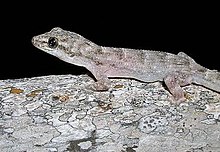| Coastal leaf-toed gecko | |
|---|---|

| |
| Conservation status | |
 Least Concern (IUCN 3.1) | |
| Scientific classification | |
| Domain: | Eukaryota |
| Kingdom: | Animalia |
| Phylum: | Chordata |
| Class: | Reptilia |
| Order: | Squamata |
| Infraorder: | Gekkota |
| Family: | Phyllodactylidae |
| Genus: | Phyllodactylus |
| Species: | P. kofordi |
| Binomial name | |
| Phyllodactylus kofordi Dixon & Huey, 1970 | |
The coastal leaf-toed gecko (Phyllodacylus kofordi), also known commonly as the Tumbesian leaf-toed gecko is a species of lizard in the family Phyllodactylidae. The species is endemic to South America.
Taxonomy
P. kofordi was described as a species new to science by James R. Dixon and Raymond B. Huey in 1970.
Etymology
The specific name, kofordi, is in honor of American zoologist Carl B. Koford.
Description
P. kofordi is a small gecko with a maximum snout-to-vent length (SVL) of 46 mm (1.8 in).
Geographic range
P. kofordi is found in Peru and southern Ecuador.
The type locality of this gecko is the Cerro La Vieja in the Peruvian Region of Lambayeque.
Habitat
The preferred natural habitats of P. kofordi are desert and dry forest, at altitudes from sea level to 638 m (2,093 ft).
Behavior
P. kofordi is terrestrial and nocturnal.
Diet
P. kofordi preys upon invertebrates, and it also eats plant material.
Reproduction
P. kofordi is oviparous.
References
- ^ Venegas P, Perez J, Aguilar C, Quiroz Rodriguez A (2016). "Phyllodactylus kofordi ". The IUCN Red List of Threatened Species 2016: e.T48442821A48442826. https://doi.org/10.2305/IUCN.UK.2016-1.RLTS.T48442821A48442826.en. Downloaded on 1 February 2019.
- ^ Phyllodactylus kofordi at the Reptarium.cz Reptile Database. Accessed 26 July 2015.
- "Tumbesian Leaf-toed Gecko". Tropical Herping. Retrieved 4 February 2019.
- Beolens, Bo; Watkins, Michael; Grayson, Michael (2011). The Eponym Dictionary of Reptiles. Baltimore: Johns Hopkins University Press. xiii + 296 pp. ISBN 978-1-4214-0135-5. (Phyllodactylus kofordi, p. 144).
- Dixon & Huey, 1970, p. 39.
Further reading
- Dixon JR, Huey RB (1970). "Systematics of the Lizards of the Gekkonid Genus Phyllodactylus of Mainland South America". Contributions in Science, Natural History Museum of Los Angeles County (192): 1–78. (Phyllodactylus kofordi, new species, pp. 39–42).
- Rösler H (2000). "Kommentierte Liste der rezent, subrezent und fossil bekannten Geckotaxa (Reptilia: Gekkonomorpha)". Gekkota 2: 28–153. (Phyllodactylus kofordi, p. 104). (in German).
- Schlüter U (2011). "Haltung und Nachzucht von Kofords Blattfingergecko (Phyllodactylus kofordi DIXON & HUEY 1970)". Elaphe 19 (2): 39–43. (in German).
- Torres-Carvajal O, Pazmiño-Otamendi G, Salazar-Valenzuela D (2019). "Reptiles of Ecuador: a resource-rich online portal, with dynamic checklists and photographic guides". Amphibian and Reptile Conservation 13 (1): 209–229.
| Taxon identifiers | |
|---|---|
| Phyllodactylus kofordi | |
This article about a gecko is a stub. You can help Misplaced Pages by expanding it. |